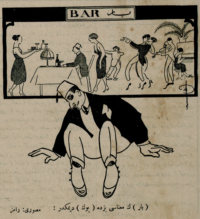Merve Köksal (Akdeniz University, Antalya)
A Background History of the Occupation: Life in the Istanbul Underground during 1918-1923

“(Bar)ın manası bizde (yük) demektir! Musavviri: Ramiz” (Bar means burden for us! Illustrator: Ramiz) from the 71st issue of Aydede, September 4 1922.
The years following the Great War had both a destructive and reconstructive impact on Istanbul, which long since sheltered the lure of multicultural and multilingual coexistence. The Allied occupation that lasted for almost five years turned the imperial capital into one of the most hectic crossroads of the world; for many people, it was a transfer point on their journey to the countries in the West. As a natural result of this fluidity, the city became an unusual melting pot that produced its idiosyncratic forms of culture. Istanbul underground, on the other hand, was a distinctive blending area that was imbued with both the trauma of these rapid changes and the productivity caused by such turmoil. Despite the peculiar cosmopolitanism and unique transnational encounters inherent to the occupation period, knowledge on the Istanbul underground that was reshaped under this turbulent atmosphere is severely obscure.
This dissertation aims to examine the pluralist underground life with an interdisciplinary approach —one that will investigate the multinational interactions through the self-narratives as well as the artistic production— and generate an alternative glance at the events through a microhistorical perspective. The main focus will be on the Asmalımescit district in Pera, an urban space which was significantly intertwined with the subjects that were ostracized based on their social and political conditions or sexual inclinations; such as the artists and intellectuals in exile, bohemians, and nightclub regulars who are usually not accessible in academic writing. Reflecting on the voluminous literary texts, diaries, memoirs, and travelogues that let us peek into the implicit life; examining the personal archives, art collections, as well as the unvalued reports and the images on the newspapers and periodicals, promises to shed light on the underground domain engaged with Asmalımescit. This research aims to reveal that the dynamism within the clandestine life during the occupation virtually bred and precipitated far-reaching social transformations in a remarkably short time which also had a profound impact on the cultural life of the early republic in Turkey. It aspires to decode the inherent productivity of Istanbul underground through the complex, yet fertile, interactions cultivated by the marginalized groups and incorporate them in the historical narratives as the actors and the narrators who composed such life.
Merve Köksal has been a PhD student in the Department of Fine Arts at Akdeniz University, Antalya, since 2019, where she is employed as a research assistant. After a BA degree in Fashion Design from Izmir University of Economics (2015) she earned her MA degree in Art and Design from Akdeniz University. Ms Köksal is currently a visiting scholar in the Orient-Institut Istanbul’s research field “Self-Narratives as Sources for the History of the Late Ottoman Empire” and a contributor to the research priority “The Protestant Cemetery at Feriköy: Documenting four centuries of Protestant presence in Turkey.”
